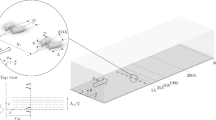Abstract
This study was concerned with the free-surface wave flow around a surface-piercing foil. The volume of fluid method implemented in a Navier–Stokes computational fluid dynamics code was employed. Three widely used discretization schemes for the volume of fluid method were assessed for a test case that involved general ship waves, spilling breaking waves in front of the leading edge, and bubbly free surfaces in separated regions. A single computational approach was selected for the comparison, and a grid-dependence study was carried out. The computational results were validated against existing experimental data, showing good agreement. The validation results suggest that all three discretization schemes perform well, but the best and most efficient results were obtained using the high-resolution interface capturing scheme.
Similar content being viewed by others
References
EH Harlow JE Welch (1965) ArticleTitleNumerical calculation of time-dependent viscous incompressible flow with free surface Phys Fluids 8 2182–2189 Occurrence Handle10.1063/1.1761178
CW Hirt BD Nichols (1981) ArticleTitleVolume of fluid method for dynamics of free boundaries J Comp Physics 39 201–221
M Sussman P Smereka S Osher (1994) ArticleTitleA level set approach for computing solutions to incompressible two-phase flow J Comp Physics 114 146–159
Azcueta R, Muzaferija S, Peric M (1999) Computation of breaking bow waves for a very full hull ship. In: Proceedings of the 7th international conference on numerical ship hydrodynamics, Nantes, France
Hino T (2004) Numerical simulations of breaking waves around an advancing ship by an unstructured NS solver. In: Proceedings of the 25th symposium on naval hydrodynamics, St. John's, Canada
Metcalf B, Longo J, Stern F (2001) Experimental investigation of wave-induced separation around a surface-piercing NACA0024 hydrofoil. In: Proceedings of the 26th American towing tank conference, Glen Cove, NY
T-H Shih WW Liou A Shabbir et al. (1995) ArticleTitleA new k-ε eddy-viscosity model for high Reynolds number turbulent flows. Model development and validation Comput Fluids 24 227–238 Occurrence Handle10.1016/0045-7930(94)00032-T
DL Youngs (1982) Time-dependent multi-material flow with large fluid distortion KW Morton MJ Baines (Eds) Numerical methods for fluid dynamics Academic Press New York
Muzaferija S, Peric M, Sames P, et al (1998) A two-fluid Navier–Stokes solver to simulate water entry. In: Proceedings of the 22nd symposium on naval hydrodynamics, Washington, DC, pp 277–289
BP Leonard (1979) ArticleTitleA stable and accurate convective modelling procedure based on quadratic upstream interpolation Comput Methods Appl Mech Eng 19 59–98 Occurrence Handle10.1016/0045-7825(79)90034-3 Occurrence Handle0423.76070
Kandasamy M (2001) RANS simulation of free-surface wave-induced separation on a surface-piercing NACA0024 hydrofoil. MS Thesis, University of Iowa, Iowa City
SH Rhee F Stern (2002) ArticleTitleRANS model for spilling breaking waves J Fluids Eng 124 424–432 Occurrence Handle10.1115/1.1467078
Author information
Authors and Affiliations
Corresponding author
About this article
Cite this article
Rhee, S., Makarov, B., Krishinan, H. et al. Assessment of the volume of fluid method for free-surface wave flow. J Mar Sci Technol 10, 173–180 (2005). https://doi.org/10.1007/s00773-005-0205-2
Received:
Accepted:
Issue Date:
DOI: https://doi.org/10.1007/s00773-005-0205-2




